I’m sure there must be a lab around somewhere I can send a soil sample to for analysis, but I don’t know one off hand. For the time being, I decided to try buying a soil testing kit and testing my garden soil myself.
I finally got around to trying out my soil testing kit today:
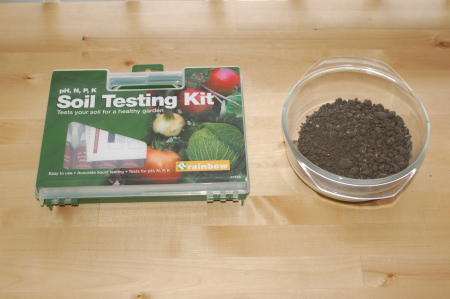
Just by looking at my soil sample I can see it is very sandy. It also contains a lot of silt because when wet it is very sloppy. The canals surrounding my garden also have a lot of silt in them. The sample appears very low in organic material. The instructions say the soil must be completely dry before testing it, and the sample above has been sitting around for a few days now.
The instructions advise doing several tests from different locations and averaging the results. For now I am just testing the one sample, but I will take more samples over time especially as I suspect problems in different parts of the garden and want to investigate further.
I suspect the previous gardener was not very sophisticated, and probably added different fertilizers and other amendments to different parts of the garden. I also saw he was growing beans in a few places, perhaps making parts of the garden higher in nitrogen than others. Unless I think there is a very obvious or urgent problem, I’m going to wait before adding anything until I have had a chance to think about it and see how things grow.
While this soil sample was taken from a part of the garden I hadn’t added anything to yet, I’ve added compost to most parts of the garden now, so if there are any nutrient problems, I have probably reduced them.
The contents of the kit looks like this:
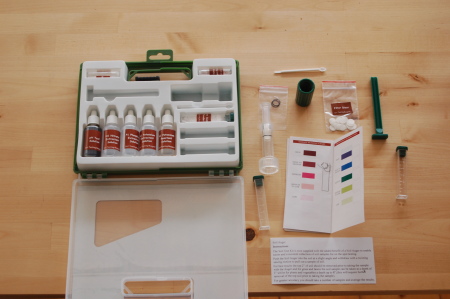
There are several bottles of liquids and vials of powders, together with some empty vials, a plunger assembly, filters and o-rings for the plunger, a few scoops and some instructions with color charts to look up results.
The kit does four soil related tests: Acidity (Ph), nitrogen (N), phosphorus (P) and potassium (K).
Except for the Ph test, where the soil is mixed directly together with the color changing chemical, all of the test have two parts. The first part involves mixing the soil together with an extractant solution, then passing it through a filter in the plunger assembly to remove the soil. The color changing chemical is then mixed separately with the extractant solution and compared to the provided charts.
Sorry this picture didn’t come out well, but this is the Ph test:
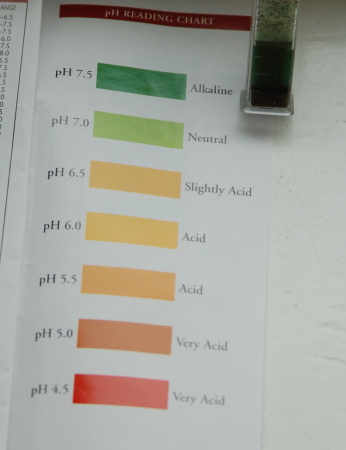
From this test I can see the soil Ph is 7.5, all the way at the far end of the test. Since the test only goes up to 7.5, and this is also my reading, it’s possible my soil is even more alkaline than that. This result conflicts with another Ph test I did a few months ago, which gave a result of 6.5.
This tells me I need to investigate this further. Perhaps there is a problem with one or both of the tests I used, or perhaps the Ph is very different in different parts in my garden.
It’s possible I have a bit of a Ph problem to deal with in the garden.
The N test:
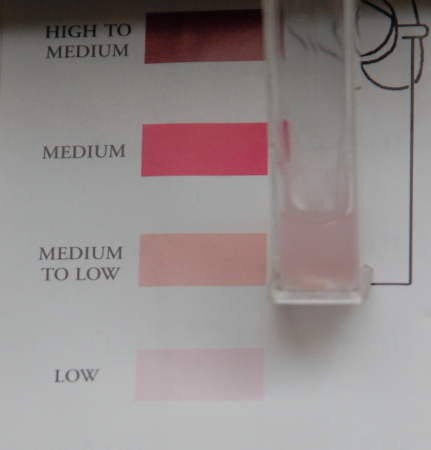
In my opinion, the results of this test lie somewhere between ‘Medium to Low’ and ‘Low’.
At least in this part of the garden, I need more N.
The P test:
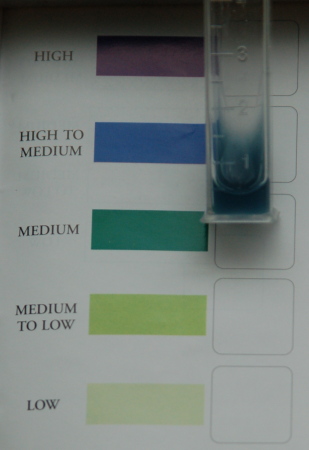
I think the results of this test are somewhere between ‘High to Medium’ and ‘Medium’, closer to the former.
At least in this part of the garden, I don’t need any more P.
K test:
For this test, I don’t have a clear picture of the results. In fact the results were very hard to read, and I don’t have much confidence in them. Perhaps after I do the test a few more times I will learn better how to read the results.
The scale looks like this:
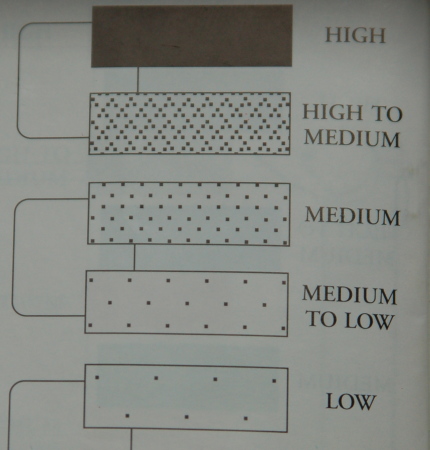
The test is supposed to result in cloudiness that you can compare to these pictures, but the result I got was almost totally clear. I repeated the test, and the second time I got a little cloudiness for a brief moment, perhaps close to the ‘Medium’ indication here, but it was really hard to know if this was right.


Hey, pretty cool! I didn’t realize there were do-it-yourself soil test kits. We are probably more likely to do one of those than we are to send samples to a lab someplace, barring any huge inconsistencies between the two methods. I’d be interested to see what results you get if you test the soil in compost-added areas of your garden.
I have only seen pH testing kits and I haven’t done a tset for while. Interesting results. I have always wondered how accurate it is to test these tiny samples but I guess if you do them here and there you will get a guide to how everything is going.I will be interested to see what conclusions you come to.
On the whole, Adelaide Plains soil is very alkaline (eastern Adelaide Hills’ is acidic) and my initial reading was 8.0 or so (our kits go up much higher than your’s, for this reason, I guess). Now, after years of adding compost, it would be interesting to test it again.
pH is often related to rainfall and I wonder how much you get. Adelaide plains (sea level) is around 500mm. Mine (I am up the hill a bit) is around 700mm and right up in the hills is more like 900 or more, possibly.
Well at least you’ll be able to grow excellent brassicas, Patrick!
A freind of mine here saw this post, and sent me a link to a local lab that will do this test. If anyone is interested, they have an English page here:
http://www.gaiabodem.nl/index.php?i=170
It’s kind of expensive: €55! Since I’ve already got a testing kit this year, maybe I’ll send them a sample to test next year.
Meg: Yes, I’m going to test some composted areas too, when I get around to it. I’m still adding more compost at the moment, so I’ll probably do this later in the year.
Kate: A pH of 8 seems really high! I’m also surprised at the amount of rainfall you get, I thought it was much less than that. I guess because of recent droughts I think of Australia as dry. Amsterdam gets a little more than 800mm on average per year.
I suspect the reason my pH is so high is the previous gardener added too much lime (I think he also used chemical fertilizers). I don’t think a pH reading like that is normal for the area. When I get a chance I’ll do a pH test somewhere else, outside my garden.
I think like you did, the only real solution is to just add lots of compost.
If it is a case of too much lime, it will wash away eventually. If I try to use sulphur to reduce the pH reading, it will take a year or two to start working anyway, and by that time it may start changing on it’s own. Since different parts of the garden seem to have different pH readings, it would also be a complex set of variables to deal with.
Compost and nitrogen fixing plants are also the apparent solution to the low nitrogen reading.
I have a lot of compost to add this year from last years garden, so we’ll see how things look after I’m done.
Soilman: Yes, there’s always the brassicas! With alkaline soil, there’s no need to worry about clubfoot. Now I need a solution like yours to keep the birds away.
I am really surprised that you can read this test pretty accurate.
I also have a test, that I am using, but the results are mostly leaving me with questions in my head. I can not really to tell what color I am getting, so I can not compare it with the scale 🙂 mabe eye doctor… hmmm…
you inspired me to take some tests at my rhodo, that I am having problems with and I cant tell the reason.
Greetings,
Ewa
Your high K values made me think someone used a lot of ashes on this piece of ground, or even made a lot of fires? Ashes can increase the Ph of the ground as well, but 8 is really high, certainly in our rainy climate. As you mentioned, things like lime (and also ashes ) should be washed out.I guess it’ll take just some time, within a few months results could be different.
Soil seems to have a higher Ph in spring, compared to the autumn value in the same spot, but I don’t remember exactly if there is a big difference.So what could be the problems? Plants won’t take up ferro-minerals as good, copper, iron, zinc,..Citrus plants are well known greedy plants for these elements (will you be growing these outside in the Netherlands?), so is sorrel and possibly cellery and a few others
Artificial non-organic fertilizers (I don’t use them) have a tendency to lower the Ph, I’m pretty sure you don’t use these either.
So , indeed, compost seems to be a good solution, and if you could get some cow’s manure, well-rotted preferably, it will help as well. Could you give an indication: which wild weeds are on the spot: thistles, nettles,or even poppies,or…Try to determinate the grasses as well, this can be useful,
Ewa: I could read them all except the K. Maybe with a little practice I’ll be able to read this too. Indeed, pH can make a big difference especially with plants like rhododendrons.
Frank: I couldn’t read the K, it was the P that was a little high. Fires are not allowed in the garden, so I don’t think there are a lot of ashes in the ground.
No, no I don’t use any artificial fertilizers either.
Good question about the weeds. There are nettles, but they grow mostly under the hedge (which I think is nitrogen fixing). I’ve also seen a few thistles, but these don’t seem to be a serious problem.
There was some weed that was really growing everywhere when I started, but I think it was an annual and it hasn’t started growing again. It was about 35cm high, with woody stems and small white flowers. I didn’t recognize it, and I haven’t been able to find it on the Internet. It was reseeding everywhere, so I know it will be back.
Grass is not a serious problem, but there is some in a few places. I’m not sure what it is, but it’s not couch (Bermuda grass).
Perhaps in a few months I’ll have some more information about the weeds.
I have never gotten around to doing this – instead have figured it out by what grows well where. This is not the way to go though.
The problem for us, with rainfall, is that it all falls in the cool months with barely anything from Dec – March, when it is so hot. So when we have water restrictions they hit very hard during the hottest, driest, sunniest part of the year. Our humidity in summer is often almost zero and this sucks the life out of the plants too!!(But it means eveporative air conditioning works like dream. And solar hot water reaches nearly boiling point.)
Well, I definitely got it completely wrong there, that’s what happens if I read something, read other things afterwards and returns to the first subject without re-reading it and just take a look at the pictures…
Nice post – i use a ph meter to tell me the ph of the soil, it’s electronic and very accurate. This way i can take various readings in different parts of the garden and compare them. It’s also a lot less messy. I think i will buy one of the tests u used though, i like the idea of being able to measure the npk level. Bit late this year to do much about it though!
kate (Kate’s Smudges): I don’t think there’s anything wrong with figuring it out by trying. In some earlier posts I’ve made a little fun of soil tests, because if you are an organic gardener there’s only ever one outcome, add more compost. Compost will fix almost any soil imbalance, and if you use a lot of compost anyway, there’s not really much point in doing a soil test. I’m doing a soil test mostly because if something is wrong I want to know about it.
Kate (Hills and Plains): Your climate sounds a lot like where I lived many years ago in northern California. What I would give for a dry season! It rains so much here.
Frank: Thanks for taking the time to leave a comment! It’s not necessary to be ‘right’, whatever that means.
vegmonkey: I use to have one of those too. I don’t know what happened to it. Yes it was nice, but but a testing kit with just a few chemical tests is much cheaper, and you don’t have the problem with breaking or mislaying it! The electronic tests also don’t work well if the ground is dry.
ooo, thanks for the post. i was just searching for soil tests like 15 minutes ago, so this is timely.
I’m particularly curious about testing for pollutants or metals. That’s probably the advantage of the expensive lab test. I just moved into a new place with some pre-existing garden area and some areas we’d like to turn into gardening space, but it’d be nice to do tests for pH and N like you did, and also for pollutants and heavy metals just in case. I’ll probably just look up a local lab that does residential soil fertility analysis.
Doviende: Good luck with the new garden! Let us know how it goes.
Testing for toxic materials is really important, especially when you live in a city. In my case, because my community garden is city owned and funded, I’m pretty sure they already did this testing.
Hi Patrick,
There’s an award waiting for you on y blog to say thanks for all the useful info. you provide.
Sue
Oh I have always wanted to try those soil test kits! They seem very accurate and organized.
I wind up watching the weeds as soil indicators (certain species of weed grow in certain soil types)…
then, I plant accordingly…(certain plants like or dislike certain soil types)..
…in otherwords, sometimes the weeds can tell me what is right or wrong with the soil.
Hi Cyndy,
I did a post on this a few months ago, as did Søren:
http://www.patnsteph.net/weblog/?p=280
I think if you are ‘reading your weeds’, there’s probably not much point in doing a soil test.
Amazing post! I love this. I like the way you explain things in a clear way. You make an excellent instructor and trainer.
Thanks for the informative post. Perhaps one day I should go about playing with a soil test kit.
where are you buy? let me know and how much is it? pls send to my email.
Hey,
I also did a test to my garden in Iceland, and results are similar. pH is 6, P and K are rather high (it’sa volcanic land) but nitrogen is terribly low (anyways it’s a country of little vegetation so this does not surprise me, and it also rains like hell, so it leaches all nitrogen away).
In fact I add manure and compost and it always results in low values of nitrogen, unless I test soil indoors (then it’s high). Either compost or nitrogen fixers only slighly increase from low to low-medium. Lots of compost increases levels to medium, but it’s obvious not a permanent or sustainable solution. Must find a solution to this problem.